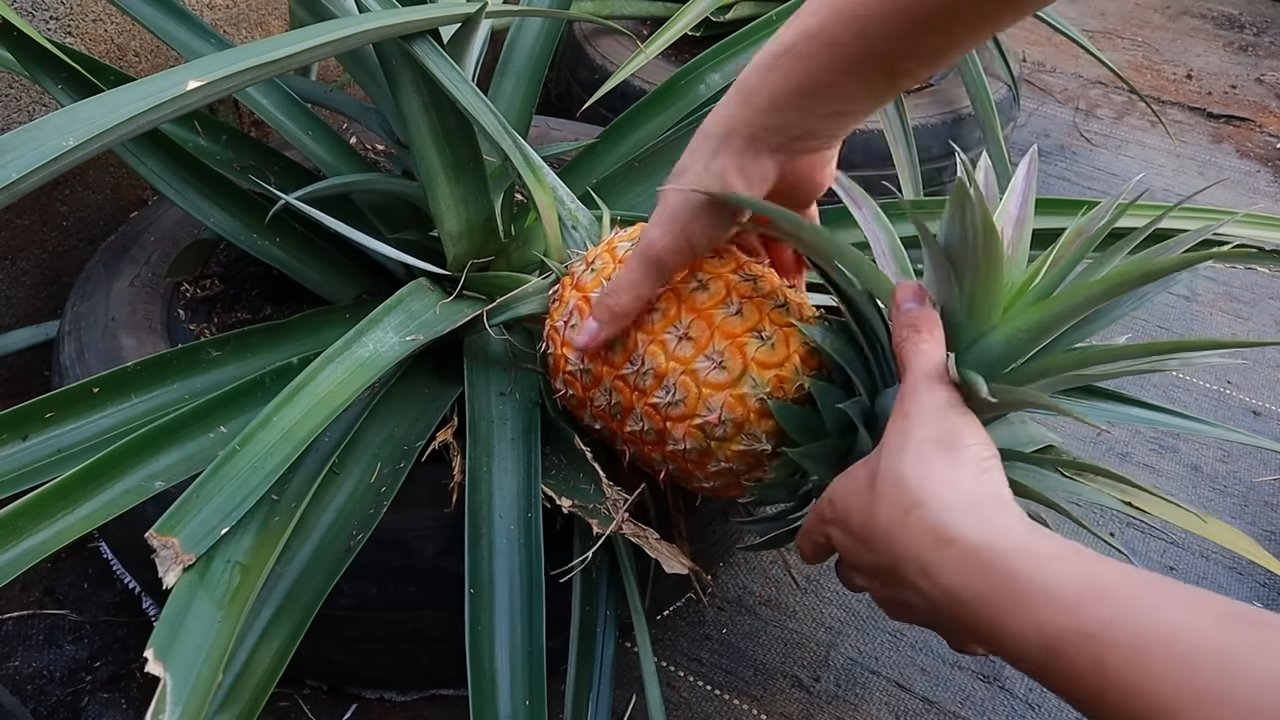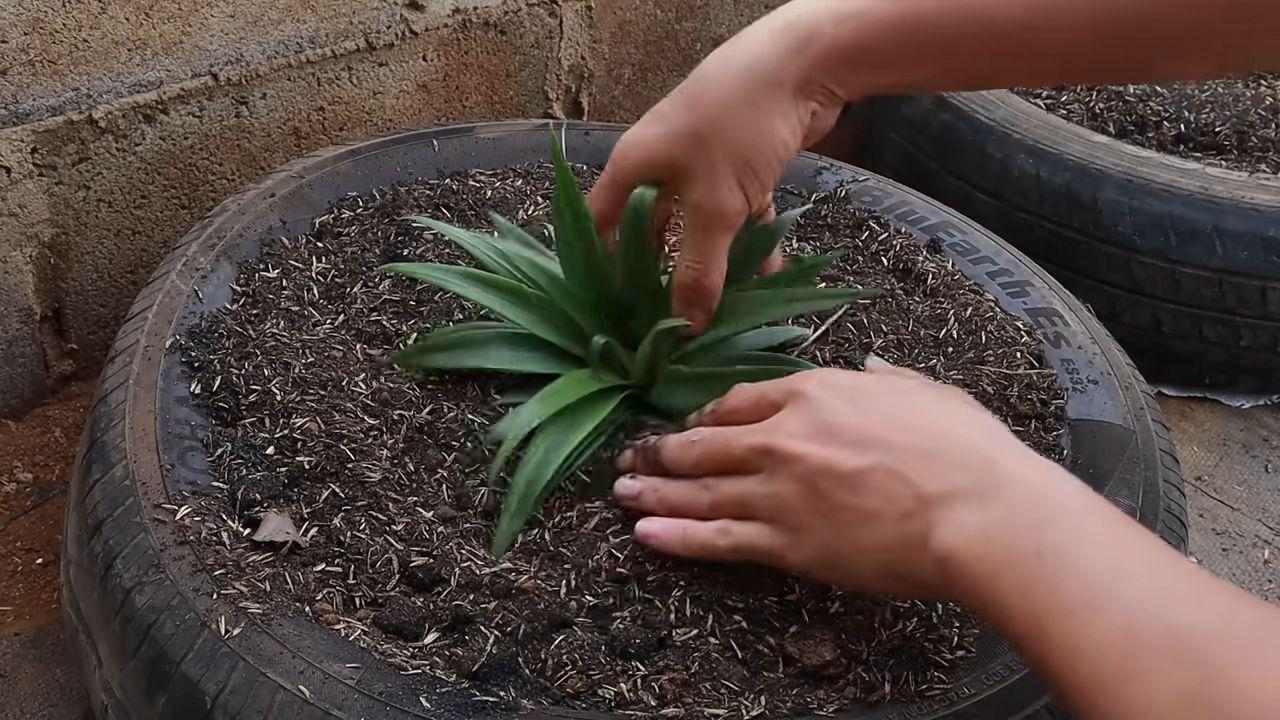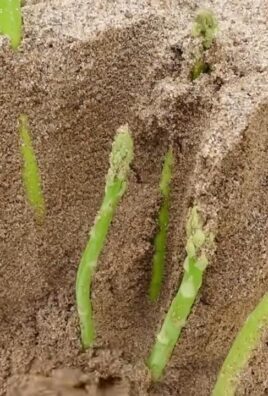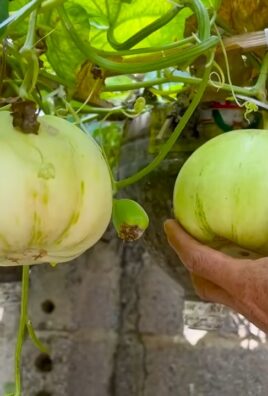Terrace Pineapple Growing Easy Method: Imagine stepping onto your terrace and plucking a juicy, sun-ripened pineapple, grown with your own two hands! Sounds like a tropical dream, right? Well, it doesn’t have to be just a dream. For centuries, pineapples were symbols of hospitality and luxury, gracing the tables of royalty and signifying a warm welcome. Now, you can bring that touch of exotic elegance to your own home, no sprawling plantation required!
I know what you’re thinking: “Pineapples? On my terrace? Isn’t that impossible?” Not at all! In this DIY guide, I’m going to share my secrets for a terrace pineapple growing easy method that even beginners can master. Forget complicated techniques and expensive equipment. We’ll break down the process into simple, manageable steps, ensuring you’ll be enjoying homegrown pineapple in no time.
Why should you try this? Because nothing beats the taste of fresh, homegrown produce, and the satisfaction of nurturing a plant from start to finish. Plus, growing your own pineapple is a fantastic conversation starter and a unique way to add a touch of the tropics to your urban oasis. So, grab your gardening gloves, and let’s get started on this exciting journey to cultivate your own sweet success!

Growing Pineapples on Your Terrace: A Tropical Delight at Home!
Hey there, fellow gardening enthusiasts! Ever dreamt of sipping on a freshly squeezed pineapple juice made from a fruit you grew yourself, right on your terrace? Well, dream no more! Growing pineapples at home is surprisingly easier than you might think, and I’m here to guide you through the process, step-by-step. Get ready to transform your terrace into a mini-tropical paradise!
What You’ll Need: The Pineapple Growing Arsenal
Before we dive in, let’s gather our supplies. Here’s a list of everything you’ll need to successfully grow pineapples on your terrace:
* A Fresh Pineapple: Choose a ripe, healthy pineapple from your local grocery store. Look for one with vibrant green leaves and no signs of rot or damage.
* A Sharp Knife: For removing the crown (the leafy top) of the pineapple.
* A Pot: A pot that’s at least 12 inches in diameter and 12 inches deep is ideal. This gives the pineapple plant enough room to grow.
* Well-Draining Potting Mix: Pineapples don’t like soggy roots, so a well-draining mix is crucial. A mix of potting soil, perlite, and sand works wonders.
* Rooting Hormone (Optional): This can help speed up the rooting process, but it’s not essential.
* Watering Can or Hose: For watering your pineapple plant.
* Fertilizer: A balanced, slow-release fertilizer is best.
* Gloves: To protect your hands.
* Spray Bottle: For misting the leaves.
Phase 1: Preparing the Pineapple Crown
This is the most crucial step, so pay close attention! We need to prepare the pineapple crown for planting.
1. Cutting the Crown: Carefully cut off the crown of the pineapple, about 1-2 inches below the leaves. Make sure you remove all the fruit flesh from the base of the crown. Any remaining fruit can rot and prevent rooting.
2. Removing the Lower Leaves: Gently peel off the bottom few layers of leaves from the crown. This will expose the stem, where the roots will eventually emerge. Don’t be afraid to pull them off; they should come off fairly easily. You should expose about an inch or two of the stem.
3. Drying the Crown: This is an important step to prevent rot. Place the crown upside down in a cool, dry place for 2-3 days. This allows the cut end to callous over. I usually put mine on a paper towel in a shaded area.
Phase 2: Rooting the Pineapple Crown
Now that our crown is prepped, it’s time to encourage those roots to grow! There are two main methods you can use: water rooting and direct planting. I’ll explain both.
Method 1: Water Rooting (My Preferred Method)
I find water rooting to be a bit more reliable because you can actually see the roots developing.
1. Prepare a Container: Find a glass or jar that’s wide enough to hold the pineapple crown but narrow enough so that only the base of the crown is submerged in water.
2. Add Water: Fill the container with clean water. Tap water is fine, but let it sit out for a day to allow the chlorine to dissipate.
3. Submerge the Base: Place the pineapple crown in the container, ensuring that only the exposed stem is submerged in water. The leaves should be above the water line.
4. Find a Sunny Spot: Place the container in a bright, indirect sunlight location. Avoid direct sunlight, which can scorch the leaves.
5. Change the Water Regularly: Change the water every 2-3 days to prevent bacteria growth.
6. Wait for Roots: Be patient! It can take anywhere from 2 to 8 weeks for roots to appear. You’ll start to see small, white roots emerging from the stem. Once the roots are about 2-3 inches long, it’s time to plant!
Method 2: Direct Planting
This method involves planting the crown directly into the potting mix.
1. Apply Rooting Hormone (Optional): If you’re using rooting hormone, dip the base of the crown into the powder or liquid. This will help stimulate root growth.
2. Prepare the Pot: Fill your pot with well-draining potting mix.
3. Plant the Crown: Make a hole in the center of the pot and carefully plant the pineapple crown, burying the stem up to the base of the leaves.
4. Water Gently: Water the soil gently, making sure not to overwater. The soil should be moist but not soggy.
5. Find a Sunny Spot: Place the pot in a bright, indirect sunlight location.
Phase 3: Planting and Caring for Your Pineapple Plant
Whether you water-rooted or directly planted, now it’s time to get your pineapple settled into its permanent home.
1. Choosing the Right Pot: Make sure your pot has drainage holes! Pineapples hate sitting in water. A terracotta pot is a good choice because it allows the soil to breathe.
2. Potting Mix is Key: Again, well-draining potting mix is essential. I like to use a mix of equal parts potting soil, perlite, and coarse sand. This ensures good drainage and aeration.
3. Planting the Rooted Crown: If you water-rooted, gently remove the crown from the water and plant it in the pot, burying the roots completely. If you directly planted, you’re already set!
4. Watering: Water thoroughly after planting. Then, allow the soil to dry out slightly between waterings. Overwatering is a common mistake, so err on the side of caution. I usually water mine about once a week, but it depends on the weather and humidity.
5. Sunlight: Pineapples love sunlight! Place your plant in a location that receives at least 6 hours of direct sunlight per day. A south-facing terrace is ideal.
6. Fertilizing: Feed your pineapple plant with a balanced, slow-release fertilizer every 2-3 months during the growing season (spring and summer). Follow the instructions on the fertilizer package. You can also use a liquid fertilizer diluted to half strength every 2 weeks.
7. Temperature: Pineapples thrive in warm temperatures, ideally between 65°F and 85°F (18°C and 29°C). Protect your plant from frost and freezing temperatures. If you live in a colder climate, you may need to bring your pineapple plant indoors during the winter.
8. Humidity: Pineapples appreciate humidity. If your terrace is dry, you can increase humidity by misting the leaves regularly with a spray bottle. You can also place the pot on a tray filled with pebbles and water, making sure the bottom of the pot doesn’t touch the water.
9. Pest Control: Keep an eye out for pests like mealybugs and scale. If you spot any, treat them with insecticidal soap or neem oil.
Phase 4: Patience is a Virtue: Waiting for Your Pineapple to Fruit
This is where the real test of patience comes in. It can take anywhere from 1 to 3 years for a pineapple plant to produce fruit. Don’t get discouraged! Just keep providing the right care, and eventually, you’ll be rewarded with a delicious pineapple.
1. Encouraging Fruiting: Once your plant is mature (about 2-3 years old), you can try to encourage fruiting by exposing it to ethylene gas. You can do this by placing a ripe apple or banana near the plant, covering both with a plastic bag for a few days. The ripening fruit will release ethylene gas, which can trigger flowering.
2. Flowering: You’ll know your pineapple plant is about to fruit when it starts to produce a flower stalk from the center of the plant. The flower stalk will eventually develop into a small pineapple.
3. Fruiting: As the pineapple grows, it will gradually increase in size and change color from green to yellow or golden.
4. Harvesting: The pineapple is ready to harvest when it’s fully colored and has a sweet aroma. Gently twist the pineapple from the plant.
Extra Tips for Terrace Pineapple Success
* Rotate Your Plant: Rotate your pineapple plant regularly to ensure even sunlight exposure.
* Prune Dead Leaves: Remove any dead or yellowing leaves to keep your plant healthy.
* Consider Companion Planting: Plant herbs like basil or rosemary around your pineapple plant to deter pests.
* Don’t Overwater: I can’t stress this enough! Overwatering is the biggest killer of pineapple plants.
* Be Patient: Growing pineapples takes time and patience. Don’t give up!
Growing pineapples on your terrace is a rewarding experience.

Conclusion
So, there you have it! Growing your own pineapples on your terrace might seem like a tropical dream reserved for expert gardeners, but with this easy method, it’s entirely within your reach. We’ve demystified the process, breaking it down into manageable steps that anyone, regardless of their gardening experience, can follow.
Why is this DIY trick a must-try? Because it offers a unique and rewarding experience that goes beyond simply buying a pineapple from the store. Imagine the satisfaction of nurturing a plant from a simple pineapple top to a fully grown, juicy fruit. Think of the bragging rights you’ll earn when you serve a homegrown pineapple to your friends and family. And consider the environmental benefits of reducing your carbon footprint by growing your own food.
But the real magic lies in the taste. Homegrown pineapples, ripened naturally under the sun, boast a flavor that’s far superior to anything you can find in a supermarket. They’re sweeter, more fragrant, and bursting with tropical goodness. Plus, you know exactly where your pineapple came from and how it was grown, ensuring a healthy and sustainable treat.
Don’t be afraid to experiment with variations! While we’ve outlined a basic method, there’s plenty of room for customization. Try using different types of potting mix to see which one works best for your climate and soil conditions. Consider adding organic fertilizers to boost growth and fruit production. You can even explore different pineapple varieties to find your favorite flavor profile. Some gardeners have had success with using larger containers or even raised beds on their terraces for increased space and drainage.
Remember, patience is key. Growing pineapples takes time, but the reward is well worth the wait. Don’t get discouraged if you don’t see results immediately. Just keep providing your pineapple plant with the right conditions – plenty of sunlight, well-drained soil, and regular watering – and it will eventually reward you with a delicious, homegrown fruit.
We wholeheartedly encourage you to give this DIY terrace pineapple growing method a try. It’s a fun, educational, and ultimately delicious project that will transform your terrace into a tropical oasis. And most importantly, we want to hear about your experience! Share your photos, tips, and stories with us in the comments below. Let’s create a community of pineapple enthusiasts and inspire others to embrace the joy of homegrown fruit.
Ready to embark on your pineapple-growing adventure? Grab a pineapple, follow our simple steps, and get ready to enjoy the sweet taste of success!
Frequently Asked Questions (FAQ)
How long does it take to grow a pineapple on a terrace?
The time it takes to grow a pineapple from a top can vary depending on several factors, including climate, sunlight, and the specific pineapple variety. Generally, it takes anywhere from 2 to 3 years for a pineapple plant to mature and produce fruit. The first year is primarily focused on root development and vegetative growth. The second year will see more significant growth, and the third year is when you can typically expect to see a pineapple forming. Be patient and consistent with your care, and you’ll be rewarded with a delicious, homegrown pineapple.
What kind of soil is best for growing pineapples in containers?
Pineapples thrive in well-draining, slightly acidic soil. A good potting mix for pineapples should be a blend of peat moss, perlite, and vermiculite. This combination provides excellent drainage, aeration, and moisture retention. You can also add some compost or aged manure to enrich the soil with nutrients. Avoid using heavy clay soils, as they can become waterlogged and lead to root rot. A pH level between 5.5 and 6.5 is ideal for pineapple growth. You can test the pH of your soil using a soil testing kit and amend it if necessary.
How much sunlight do pineapples need when grown on a terrace?
Pineapples are sun-loving plants and require at least 6 to 8 hours of direct sunlight per day to thrive. When growing pineapples on a terrace, choose a location that receives ample sunlight throughout the day. If your terrace doesn’t get enough direct sunlight, you may need to supplement with artificial lighting, especially during the winter months. Insufficient sunlight can lead to stunted growth, reduced fruit production, and a less flavorful pineapple.
How often should I water my pineapple plant on the terrace?
Watering frequency depends on the climate, the size of the container, and the type of soil you’re using. Generally, you should water your pineapple plant when the top inch of soil feels dry to the touch. During the growing season (spring and summer), you may need to water more frequently, perhaps every 2 to 3 days. In the cooler months (fall and winter), reduce watering to once a week or even less. Avoid overwatering, as this can lead to root rot. Ensure that the container has adequate drainage holes to prevent water from accumulating at the bottom.
How do I fertilize my pineapple plant on the terrace?
Pineapples are heavy feeders and benefit from regular fertilization. Use a balanced fertilizer with a ratio of 10-10-10 or 14-14-14. Apply the fertilizer every 2 to 3 months during the growing season. You can also use organic fertilizers, such as compost tea or fish emulsion. Dilute the fertilizer according to the manufacturer’s instructions and apply it to the soil around the base of the plant. Avoid getting fertilizer on the leaves, as this can cause burning.
How do I encourage my pineapple plant to flower and produce fruit?
To encourage flowering, you can try a few different methods. One common technique is to expose the plant to ethylene gas. You can do this by placing a ripe apple or banana near the plant and covering it with a plastic bag for a few days. The ethylene gas released by the fruit will stimulate flowering. Another method is to apply a small amount of calcium carbide to the center of the plant. Calcium carbide releases acetylene gas, which also promotes flowering. Be careful when handling calcium carbide, as it can be irritating to the skin and eyes.
What are some common pests and diseases that affect pineapple plants?
Pineapples can be susceptible to a few pests and diseases. Common pests include mealybugs, scale insects, and spider mites. These pests can be controlled with insecticidal soap or neem oil. Diseases that can affect pineapples include root rot, heart rot, and pineapple wilt. Root rot is caused by overwatering and can be prevented by ensuring good drainage. Heart rot is a fungal disease that can be treated with a fungicide. Pineapple wilt is a viral disease that is spread by mealybugs. Control mealybugs to prevent the spread of pineapple wilt.
Can I grow multiple pineapple plants in the same container?
It’s generally best to grow each pineapple plant in its own container to ensure that it has enough space and nutrients to thrive. Growing multiple plants in the same container can lead to competition for resources and stunted growth. If you want to grow multiple pineapple plants, use separate containers that are at least 12 inches in diameter.
What do I do with the pineapple after I harvest it?
Once you harvest your pineapple, you can enjoy it fresh, grilled, or in smoothies and desserts. You can also use the pineapple top to start a new plant, continuing the cycle of homegrown goodness. Don’t forget to share your delicious, homegrown pineapple with friends and family!




Leave a Comment